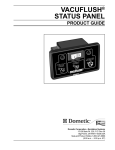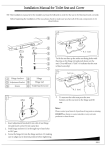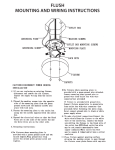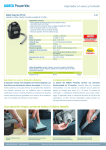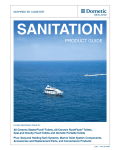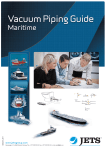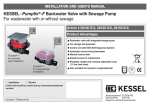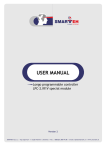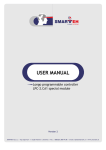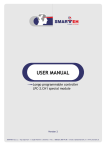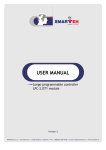Download SeaLand electronic toilet flush switch instructions-template
Transcript
EN Electronic flush switches installation and operation manual VFS, VFP models for VacuFlush toilets DFS, DFP models for other SeaLand toilets SeaLand® Electronic Flush Switches IN STA L L AT I O N • O PER AT I O N VFS, VFP flush switches for VacuFlush electric-flush toilets DFS, DFP flush switches for MasterFlush and RushFlush electric-flush toilets CE approved 1 1Installation 1.1 Internal function switches The SeaLand flush switch includes a set of internal function switches inside the back of the panel which allow it to operate with new and older SeaLand electric-flush toilets. The normal position of the panel’s internal function switches for new toilets are: VFS and VFP panels DFS and DFP panels WHEN INSTALLING A SEALAND ELECTRONIC FLUSH SWITCH with OLDER VACUFLUSH OR MASTERFLUSH TOILET (serial number on toilet ID label contains prefix “223” or lower) 1. With small flat screwdriver, unsnap back cover from switch panel to reveal circuit board (fig. 1 ). 2. Locate internal function switches (fig. 2 ). 3. Push switches to lower position as shown (fig. 3 ). These settings enable backlighting of flush switches, and disable backlighting of VFS and VFP panel’s “Service” switch (which does not operate with older VacuFlush electronic-flush toilets). 4. Reassemble panel and install according to instructions in Section 1.2. 1 2 3 Note These instructions apply only to panels installed with OLDER Dometic and SeaLand electronic-flush toilets. It is not necessary to reset internal function switches installed with new toilets. 2 1.2 Flush switch panel VFS, VFP models for VacuFlush toilets DFS, DFP models for other SeaLand toilets Caution! If replacing a previous electronic flush switch, WITH ELECTRICAL POWER OFF, be sure to disconnect wiring from old switch before installing new flush switch. NEW INSTALLATION 1. Plan flush switch location so cable can reach toilet base circuit board. Be sure cable cannot get wet. 2. Using correct Dometic, Vimar or Gewiss panel template (see Section 5), mark center access and fastener holes. Cut out square access hole to size (fig. 4 ). Make sure there is at least 2 inches (51 mm) of clearance behind wall surface. 3. Route flush switch cable from wall access hole to floor access hole at toilet base, leaving about 12 inches (305 mm) of extra cable at toilet. 4. Attach cable to back of flush switch circuit board (fig. 4 ), then fasten flush switch bracket to wall with supplied screws (fig. 5 ). 5. Snap Dometic, Vimar or Gewiss cover plate onto bracket (fig. 5 ) at proper connection points (see Section 6, back page). 6. WITH ELECTRICAL POWER OFF, connect wiring cable from the flush switch to the RJ45 connector on the circuit board of the toilet base (fig. 6 ). 4 5 6 3 2 MasterFlush Toilet Operation with DFS or DFP Flush Switch 2.1 Toilet system start-up 1. Turn on electrical power and water supply to toilet. 2. Press Flush switch once. After nine seconds of water flow, macerator pump will start and run for about six seconds to clear bowl. It will take about five seconds to refill bowl. 3. Toss several sheets of toilet paper into bowl and repeat cycle. The bowl should completely clear. 2.2 Normal toilet operation ADDING WATER TO TOILET BOWL Press “Add Water” switch until desired water level is achieved. More water is usually added only when flushing solids. (If switch is pressed too long, water flow will shut off automatically to avoid overflow.) BACKLIGHTING: To turn switch backlighting effect off or on, push “Add Water” switch twice very quickly. FLUSHING TOILET Press “Flush” switch down, then release it. This activates a powerful macerator pump that siphons water and waste from the bowl, macerates, and propels the effluent through the discharge line to the holding tank. DO NOT FLUSH FOREIGN OBJECTS CAUTION! Flush only water, bodily wastes and rapid-dissolving tissue paper. Do not flush wet wipes, sanitary napkins, condoms, diapers, razor blades paper cups, cotton swabs food, hair or liquids such as oils or solvents. Clogging or damage to the toilet system may occur. Note Make sure all guests understand toilet operation before use. 2.3 Changing flush modes MasterFlush toilets offer two flush settings to help manage water consumption: Normal flush – Uses 0.85 gal. (3.2 liters) per flush. Adds water to bowl after every flush. Dry Bowl flush – Uses 0.45 gal. (1.7 liters) per flush. Does not add water to bowl after flush. To change from Normal to Dry Bowl flush setting, press “Flush” switch for about five seconds. When “Power” light begins flashing, release “Flush” switch. Flush mode has been changed to Dry Bowl setting. Change mode to Normal flush by following the same procedure. 2.4 Indicator lights “POWER” INDICATOR On the Dometic flush switch panel, a steady green “Power” light indicates when electrical power to the toilet is activated. “TANK LEVEL” INDICATOR The Dometic flush switch panel includes a “Tank Level” light to indicate holding tank status (if connected to appropriate tank monitoring system) and when it should be pumped out. When the light is yellow, the tank is 3/4 full. When the light is red, the holding tank is full and electrical power to the toilet automatically shuts off to prevent overfill of the holding tank. After the holding tank is emptied, the light will turn off and electrical power to the toilet is restored. 4 3 RushFlush Toilet Operation with DFS, DFP Flush Switch 3.1 Toilet system start-up 1. Turn on eletrical power and water supply to toilet system. 2. Press “Flush” switch once. 3. Toss several sheets of toilet paper into bowl and repeat cycle. The bowl should completely clear. 4. If tissue paper does not completely discharge from toilet bowl, flow times for the rim and lower water jets may need to be increased. On RushFlush toilet’s water flow control module (fig. 7 ), adjust water flow times to higher setting. Repeat flush test after each adjustment to assure tissue paper discharges from toilet bowl. 3.2 7 Normal toilet operation ADDING WATER TO TOILET BOWL Press “Add Water” switch until desired water level is achieved. More water is usually added only when flushing solids. (If switch is pressed too long, water flow will shut off automatically to avoid overflow.) BACKLIGHTING: To turn switch backlighting effect off or on, push “Add Water” switch twice very quickly. FLUSHING TOILET Press “Flush” switch, then release it. This activates a powerful water jet action that breaks up and discharges effluent from the bowl, through the discharge loop and to the holding tank. DO NOT FLUSH FOREIGN OBJECTS CAUTION! Flush only water, bodily wastes and rapid-dissolving tissue paper. Do not flush wet wipes, sanitary napkins, condoms, diapers, razor blades paper cups, cotton swabs food, hair or liquids such as oils or solvents. Clogging or damage to the toilet system may occur. Note Make sure all guests understand toilet operation before use. 3.3 Indicator lights “POWER” INDICATOR On the Dometic flush switch panel, a steady green “Power” light indicates when electrical power to the toilet is activated. “TANK LEVEL” INDICATOR The Dometic flush switch panel includes a “Tank Level” light to indicate holding tank status (if connected to appropriate tank monitoring system) and when it should be pumped out. When the light is yellow, the tank is 3/4 full. When the light is red, the holding tank is full and electrical power to the toilet automatically shuts off to prevent overfill of the holding tank. After the holding tank is emptied, the light will turn off and electrical power to the toilet is restored. 5 4 VacuFlush Toilet Operation with VFS or VFP Flush Switch 4.1 Toilet system start-up 1. Turn on electrical power and water supply to toilet. 2. Flush water through entire toilet system by flushing toilet five times (press “Flush” switch and allow each flush cycle to complete until green light indicates system is ready for next flush). Each cycle takes about one minute. 4.2 Normal toilet operation Add Water to Toilet Bowl (and panel backlighting function) Press “Add Water” switch until desired water level is achieved. More water is usually added only when flushing solids. (If switch is pressed too long, water flow will shut off automatically to avoid overflow.) BACKLIGHTING: To turn switch backlighting effect off or on, push “Add Water” switch twice very quickly. FLUSH TOILET Press “Flush” switch down for a moment, then release it. Flush only when the green “OK to Flush” light is on. Toilet will not flush until the green “OK to Flush” light is on. It takes about one minute for vacuum to recharge for the next flush. If the red “Do Not Flush” light is on, the system is either recharging the vacuum, or the holding tank is full. Do not attempt to flush the toilet during these conditions, or a clog may occur in the toilet system. DO NOT FLUSH FOREIGN OBJECTS CAUTION! Flush only water, bodily wastes and rapid-dissolving tissue paper. Do not flush wet wipes, sanitary napkins, condoms, diapers, razor blades paper cups, cotton swabs food, hair or liquids such as oils or solvents. Clogging or damage to the toilet system may occur. Note Make sure all guests understand toilet operation before use. 4.3 Changing flush modes SeaLand VacuFlush all-ceramic toilets offer two flush settings to help manage water consumption: Normal flush – Uses 1 quart (0.95 liter) per flush. Adds water to bowl after every flush. Dry Bowl flush – Uses 1 pint (0.5 liter) per flush. Does not add water to bowl after flush. To change from Normal to Dry Bowl flush setting, press “Flush” switch for about five seconds. When green “OK to Flush” light on status panel begins flashing, release “Flush” switch. Flush mode has been changed to Dry Bowl setting. Change mode to Normal flush by following the same procedure. 4.4 Indicator lights “OK TO FLUSH” INDICATOR A steady green “OK to Flush” light indicates when the toilet is ready to flush. A momentary flashing green light indicates when flush mode is changing. (continued on next page) 6 “DO NOT FLUSH” INDICATOR A red “Do Not Flush” light indicate two possible toilet system conditions: 1. vacuum level in toilet system is not sufficient for complete flush. 2. holding tank is full and should be pumped out. When the red light is on, electrical power to the toilet automatically shuts off to prevent possible overfilling of the holding tank. 4.5 Service mode To clean the toilet bowl or perform other service that requires keeping the flush ball open without running water, use the Service switch. 1. Push the Service button for three seconds. The steady backlight will change to a flashing light while the toilet is in Service mode. 2. Perform the service operation. After the Service operation is complete, press the Service buttom for three seconds to change back to normal toilet operation. 5 Flush Switch Wall Templates Note See important information on back page before using either template. 2 in. (51 mm) 2 in. (51 mm) clearance behind wall surface required VFS and DFS WALL BRACKET 1.875 in. (64 mm) VFP and DFP WALL BRACKET 2.25 in. (57 mm) 2 in. (51 mm) clearance behind wall surface required 2.5 in. (64 mm) 7 6 Cover Plate Connection Points 1 Dometic 3 Gewiss Chorus 2 Vimar Eikon* 4 Vimar Idea 5 Gewiss Playbus * Gray line indicates area to be removed for Eikon series cover plate. Remove from both sides of bracket. 1 4 3 4 3 1 2 2 2 2 3 4 3 4 VFS and DFS WALL BRACKET 1 1 5 5 5 5 VFP and DFP WALL BRACKET ® Registered; ™ Trademark of Dometic Corporation © Dometic Corporation 600346829 02 1112 8 DOMETIC CORPORATION SANITATION DIVISION 13128 SR 226 | PO BOX 38 BIG PRAIRIE, OHIO 44611 USA www.dometic.com








